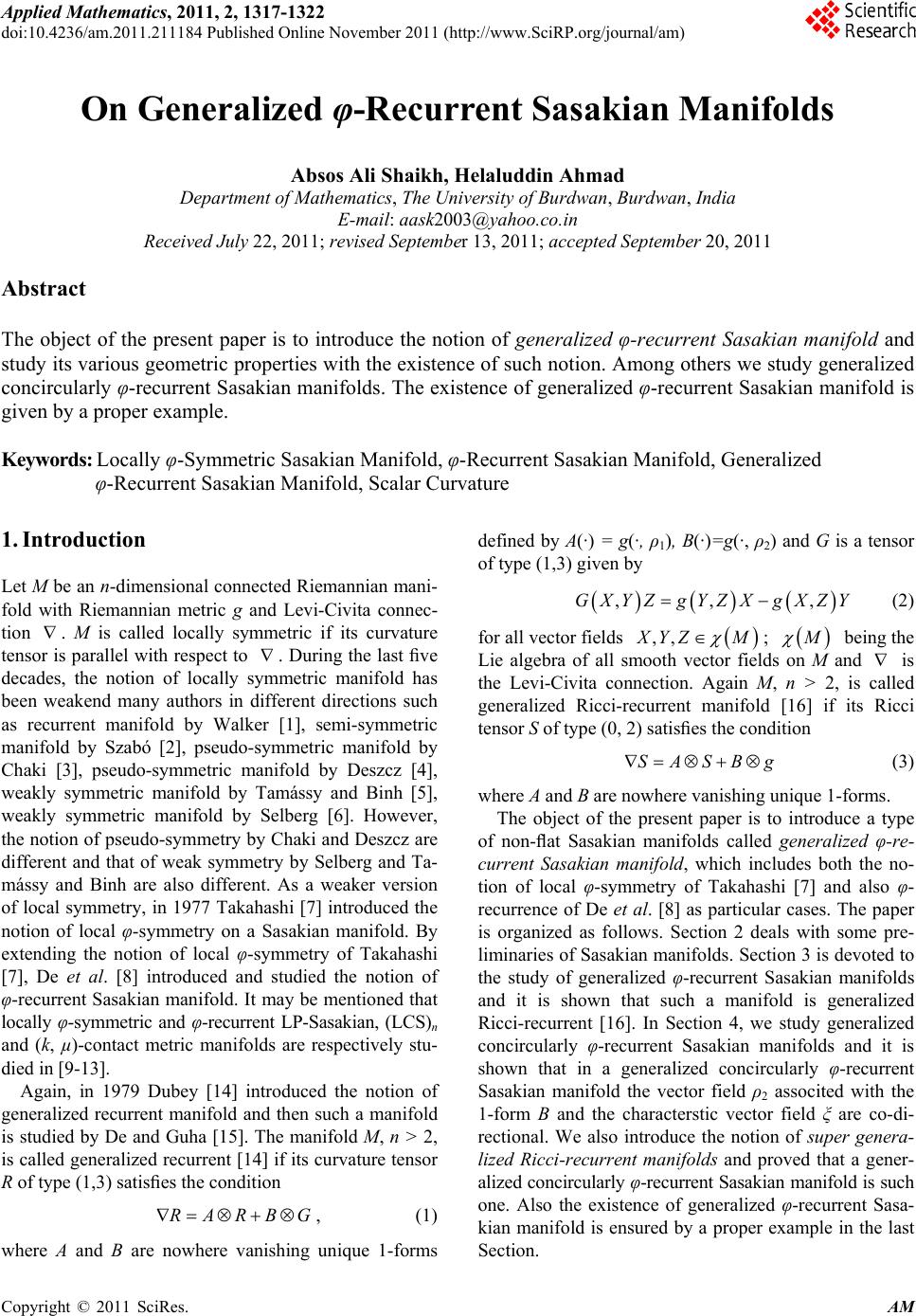 Applied Mathematics, 2011, 2, 1317-1322 doi:10.4236/am.2011.211184 Published Online November 2011 (http://www.SciRP.org/journal/am) Copyright © 2011 SciRes. AM On Generalized φ-Recurrent Sasakian Manifolds Absos Ali Shaikh, Helaluddin Ahmad Department of Mathematics, The University of Burdwan, Bur dwan , India E-mail: aask2003@yahoo.co.in Received July 22, 2011; revised September 13, 2011; accepted September 20, 2011 Abstract The object of the present paper is to introduce the notion of generalized φ-recurrent Sasakian manifold and study its various geometric properties with the existence of such notion. Among others we study generalized concircularly φ-recurrent Sasakian manifolds. The existence of generalized φ-recurrent Sasakian manifold is given by a proper example. Keywords: Locally φ-Symmetric Sasakian Manifold, φ-Recurrent Sasakian Manifold, Generalized φ-Recurrent Sasakian Manifold, Scalar Curvature 1. Introduction Let M be an n-dimensional connected Riemannian mani- fold with Riemannian metric g and Levi-Civita connec- tion . M is called locally symmetric if its curvature tensor is parallel with respect to . During the last five decades, the notion of locally symmetric manifold has been weakend many authors in different directions such as recurrent manifold by Walker [1], semi-symmetric manifold by Szabό [2], pseudo-symmetric manifold by Chaki [3], pseudo-symmetric manifold by Deszcz [4], weakly symmetric manifold by Tamássy and Binh [5], weakly symmetric manifold by Selberg [6]. However, the notion of pseudo-symmetry by Chaki and Deszcz are different and that of weak symmetry by Selberg and Ta- mássy and Binh are also different. As a weaker version of local symmetry, in 1977 Takahashi [7] introduced the notion of local φ-symmetry on a Sasakian manifold. By extending the notion of local φ-symmetry of Takahashi [7], De et al. [8] introduced and studied the notion of φ-recurrent Sasakian manifold. It may be mentioned that locally φ-symmetric and φ-recurrent LP-Sasakian, (LCS)n and (k, µ)-contact metric manifolds are respectively stu- died in [9-13]. Again, in 1979 Dubey [14] introduced the notion of generalized recurrent manifold and then such a manifold is studied by De and Guha [15]. The manifold M, n > 2, is called generalized recurrent [14] if its curvature tensor R of type (1,3) satisfies the condition RARBG , (1) where A and B are nowhere vanishing unique 1-forms defined by A(·) = g(·, ρ1), B(·)=g(·, ρ2) and G is a tensor of type (1,3) given by ,, ,GXYZgYZX gXZY (2) for all vector fields ,, YZ M ; being the Lie algebra of all smooth vector fields on M and is the Levi-Civita connection. Again M, n > 2, is called generalized Ricci-recurrent manifold [16] if its Ricci tensor S of type (0, 2) satisfies the condition SASBg (3) where A and B are nowhere vanishing unique 1-forms. The object of the present paper is to introduce a type of non-flat Sasakian manifolds called generalized φ-re- current Sasakian manifold, which includes both the no- tion of local φ-symmetry of Takahashi [7] and also φ- recurrence of De et al. [8] as particular cases. The paper is organized as follows. Section 2 deals with some pre- liminaries of Sasakian manifolds. Section 3 is devoted to the study of generalized φ-recurrent Sasakian manifolds and it is shown that such a manifold is generalized Ricci-recurrent [16]. In Section 4, we study generalized concircularly φ-recurrent Sasakian manifolds and it is shown that in a generalized concircularly φ-recurrent Sasakian manifold the vector field ρ2 associted with the 1-form B and the characterstic vector field ξ are co-di- rectional. We also introduce the notion of super genera- lized Ricci-recurrent manifolds and proved that a gener- alized concircularly φ-recurrent Sasakian manifold is such one. Also the existence of generalized φ-recurrent Sasa- kian manifold is ensured by a proper example in the last Section.  A. A. SHAIKH ET AL. 1318 0 g 2. Sasakian Manifolds An n= (2m + 1)-dimensional C∞ manifold M is said to be a contact manifold if it carries a global 1-form η such that everywhere on the manifold. Given a contact form η, it is well-known that there exists a unique vector field ξ, called the characteristic vector field of η, satisfying and for any vector field X on M. A Riemannian metric g is said to be an associated metric if there exists a tensor field φ of type (1,1) such that 0 m d 1 ,dX 2, ,, d,,Ig (4) 0,0, ,,gg (5) ,,gg . (6) Then the structure ,,, on M is called a con- tact metric stucture and the manifold M equipped with such a stucture is called a contact metric manifold [17]. Given a contact metric manifold M we define a (1,1) tensor field h by 1£ 2 h , where denotes the ope- £ rator of Lie differentiation. Then h is symmetric. The vector field ξ is a Killing vector field with respect to g if and only if . A contact metric manifold M for which ξ is a Killing vector is said to be a K-contact ma- nifold. A contact structure on M gives rise to an almost complex structure J on the product 0h defined by dd ,,( dd JXfX fX tt ), where f is a real valued function, is integrable, then the structure is said to be normal and the manifold M is a Sasakian manifold. Equivalently, a contact metric mani- fold is Sasakian if and only if ,RXYYX XY (7) holds for all X, Y where R denotes the curvature tensor of the manifold. In an n-dimensional Sasakian manifold M the follow- ing relations hold [17-19]: ,, ,, X RXYYgXY YX RX Y (8) ,, XX YgXY , (9) ,, ,RXYZgYZXgXZY 1, , (10) ,1,, SXnX Sn (11) ,,1SXY SXYnXY , (12) ,, 1, WSYSYWn gYW ,, ,, WRXY gWYX , WXYRXYW (14) ,, ,,, WRXZgXZ W ZWXRXWZ (15) for all vector fields ,,, YZWM . Definition 1. [7] A Sasakian manifold is said to be lo- cally φ-symmetric if 2, WRXYZ 0 (16) for all vector fields X, Y, Z, W orthogonal to ξ. Definition 2. [8] A Sasakian manifold is said to be φ-recurrent if there exists a nowhere vanishing unique 1-form A such that 2,, WRXYZ AWRXYZ (17) for all vector fields ,,, YZWM . Especially, if the 1-form A vanishes and the vector fields are horizontal, then the manifold turns to be a lo- cally φ-symmetric Sasakian manifold [7]. 3. Generalized φ-Recurrent Sasakian Manifolds Definition 3. An n-dimensional, n ≥ 3, Sasakian mani- fold M is said to be a generalized φ-recurrent if its cur- vature tensor satisfies the relation 22 2 ,, , WR XYZAWRXYZ BWG XY Z (18) for all ,,, YZWM , where A and B are nowhere vanishing unique 1-forms such that 1 ,AX gX , 2 ,gXBX and G(X, Y )Z is defined in (2). We consider a Sasakian manifold M, n ≥ 3, which is generalized φ-recurrent. Then by virtue of (4), (18) yields ,, ,, ,,, WW R XYZR XYZ AWR XYZRXY Z BW GXYZGXYZ (19) from which it follows that ,, , ,, , ,, , . WW RXYZURXYZ U AWg RXYZUR XYZU BWgG XY ZUG XY ZU (20) Let :1,2,, i ei n be an orthonormal basis of the tangent space at any point of the manifold. Then putting , (13) Copyright © 2011 SciRes. AM 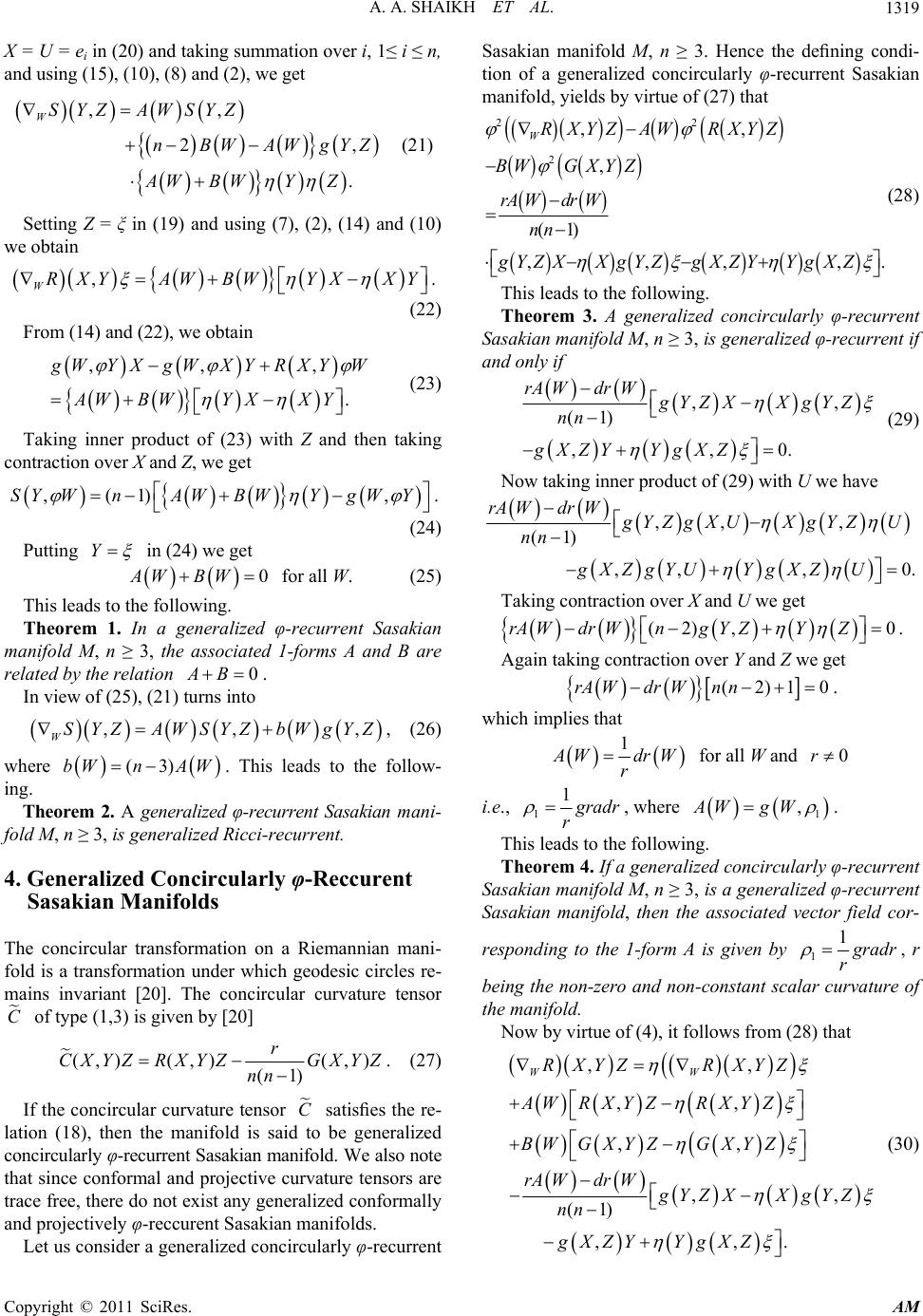 A. A. SHAIKH ET AL.1319 X = U = ei in (20) and taking summation over i, 1≤ i ≤ n, and using (15), (10), (8) and (2), we get ,, 2, . WSYZ AWSYZ nBWAWgYZ AW BWYZ (21) Setting Z = ξ in (19) and using (7), (2), (14) and (10) we obtain , WRXYAW BWYXXY . (22) From (14) and (22), we obtain ,,, . WYXgW XYRXYW AWBWYXX Y (23) Taking inner product of (23) with Z and then taking contraction over X and Z, we get ,(1),SY WnAWBWYgWY . (24) Putting Y in (24) we get 0AW BW for all W. (25) This leads to the following. Theorem 1. In a generalized φ-recurrent Sasakian manifold M, n ≥ 3, the associated 1-forms A and B are related by the relation . 0AB In view of (25), (21) turns into ,, WSYZAWSYZ bWgYZ , , (26) where . This leads to the follow- ing. (3)bWn AW Theorem 2. A generalized φ-recurrent Sasakian mani- fold M, n ≥ 3, is generalized Ricci-recurrent. 4. Generalized Concircularly φ-Reccurent Sasakian Manifolds The concircular transformation on a Riemannian mani- fold is a transformation under which geodesic circles re- mains invariant [20]. The concircular curvature tensor of type (1,3) is given by [20] C (,) (,)(,) (1) r CXYZ RXYZGXYZ nn . (27) If the concircular curvature tensor C satisfies the re- lation (18), then the manifold is said to be generalized concircularly φ-recurrent Sasakian manifold. We also note that since conformal and projective curvature tensors are trace free, there do not exist any generalized conformally and projectively φ-reccurent Sasakian manifolds. Let us consider a generalized concircularly φ-recurrent Sasakian manifold M, n ≥ 3. Hence the defining condi- tion of a generalized concircularly φ-recurrent Sasakian manifold, yields by virtue of (27) that 22 2 ,, , (1) ,,, WRXYZAWRXYZ BWG XYZ rA WdrW nn gYZXXgYZgXZYYgXZ ,. (28) This leads to the following. Theorem 3. A generalized concircularly φ-recurrent Sasakian manifold M, n ≥ 3, is generalized φ-recurrent if and only if ,, (1) ,,0. rA WdrW YZ XXgYZ nn gXZYYgXZ (29) Now taking inner product of (29) with U we have ,, , (1) ,, , rA WdrW 0. YZgXUX gYZU nn gXZgYUYgXZ U Taking contraction over X and U we get (2) ,rA WdrWngYZYZ 0 . Again taking contraction over Y and Z we get (2)10rA WdrWn n . which implies that 1 WdrW r for all W and 0r i.e., 1 1 radr r , where 1 ,AW gW . This leads to the following. Theorem 4. If a generalized concircularly φ-recurrent Sasakian manifold M, n ≥ 3, is a generalized φ-recurrent Sasakian manifold, then the associated vector field cor- responding to the 1-form A is given by 1 1 radr r , r being the non-zero and non-constant scalar curvature of the manifold. Now by virtue of (4), it follows from (28) that ,, ,, ,, ,, (1) ,,. WW RXYZ RXYZ AW RXYZRXYZ BW GXYZGXYZ rA WdrW YZ XX gYZ nn gXZY YgXZ (30) Copyright © 2011 SciRes. AM 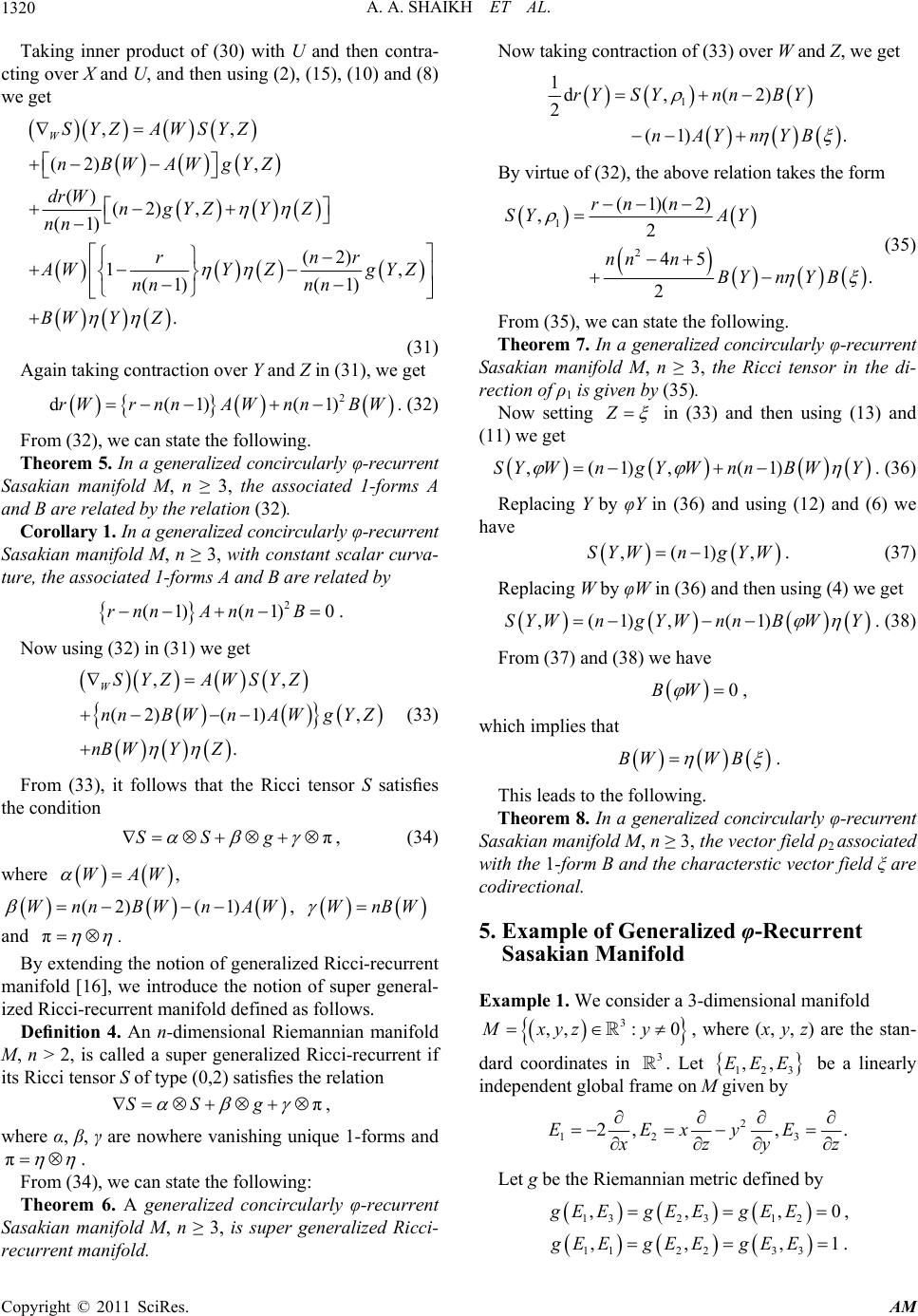 A. A. SHAIKH ET AL. 1320 Taking inner product of (30) with U and then contra- cting over X and U, and then using (2), (15), (10) and (8) we get ,, (2) , ()(2) , (1) (2) 1, (1) (1) . WSYZ AWSYZ nBWAWgYZ dr WngYZ YZ nn rnr WYZg nn nn BW YZ YZ (31) Again taking contraction over Y and Z in (31), we get 2 d(1)(1)rWrnnAWnnBW . (32) From (32), we can state the following. Theorem 5. In a generalized concircularly φ-recurrent Sasakian manifold M, n ≥ 3, the associated 1-forms A and B are related by the relation (32). Corollary 1. In a generalized concircularly φ-recurrent Sasakian manifold M, n ≥ 3, with constant scalar curva- ture, the associated 1-forms A and B are related by 2 (1)(1) 0rnnAnn B . Now using (32) in (31) we get ,, (2)(1), . WSYZ AWSYZ nnBWnAWg Y Z nB WYZ (33) From (33), it follows that the Ricci tensor S satisfies the condition πSSg , (34) where , ,WAW (2)Wnn BW (1)nAW WnBW and π . By extending the notion of generalized Ricci-recurrent manifold [16], we introduce the notion of super general- ized Ricci-recurrent manifold defined as follows. Definition 4. An n-dimensional Riemannian manifold M, n > 2, is called a super generalized Ricci-recurrent if its Ricci tensor S of type (0,2) satisfies the relation πSSg , where α, β, γ are nowhere vanishing unique 1-forms and π . From (34), we can state the following: Theorem 6. A generalized concircularly φ-recurrent Sasakian manifold M, n ≥ 3, is super generalized Ricci- recurrent manifold. Now taking contraction of (33) over W and Z, we get 1 1d,(2) 2 (1) rY SYnnBY nAYnYB . By virtue of (32), the above relation takes the form 1 2 (1)(2) ,2 45 . 2 rn n SY AY nn n BYnY B (35) From (35), we can state the following. Theorem 7. In a generalized concircularly φ-recurrent Sasakian manifold M, n ≥ 3, the Ricci tensor in the di- rection of ρ1 is given by (35). Now setting Z in (33) and then using (13) and (11) we get ,( 1),( 1)SY WngY WnnBWY . (36) Replacing Y by φY in (36) and using (12) and (6) we have ,(1),SYWn gYW . (37) Replacing W by φW in (36) and then using (4) we get ,(1),(1)SYWngYWnnB WY . (38) From (37) and (38) we have 0BW , which implies that BWWB . This leads to the following. Theorem 8. In a generalized concircularly φ-recurrent Sasakian manifold M, n ≥ 3, the vector field ρ2 associated with the 1-form B and the characterstic vector field ξ are codirectional. 5. Example of Generalized φ-Recurrent Sasakian Manifold Example 1. We consider a 3-dimensional manifold 3 ,,:0Mxyzy 3 , where (x, y, z) are the stan- dard coordinates in . Let be a linearly independent global frame on M given by 123 ,,EEE 2 12 3 2,, .EExyE zy z Let g be the Riemannian metric defined by 1323 12 ,,,gEE gEE gEE0 , 112233 ,,,gEEgEEgE E1 . Copyright © 2011 SciRes. AM 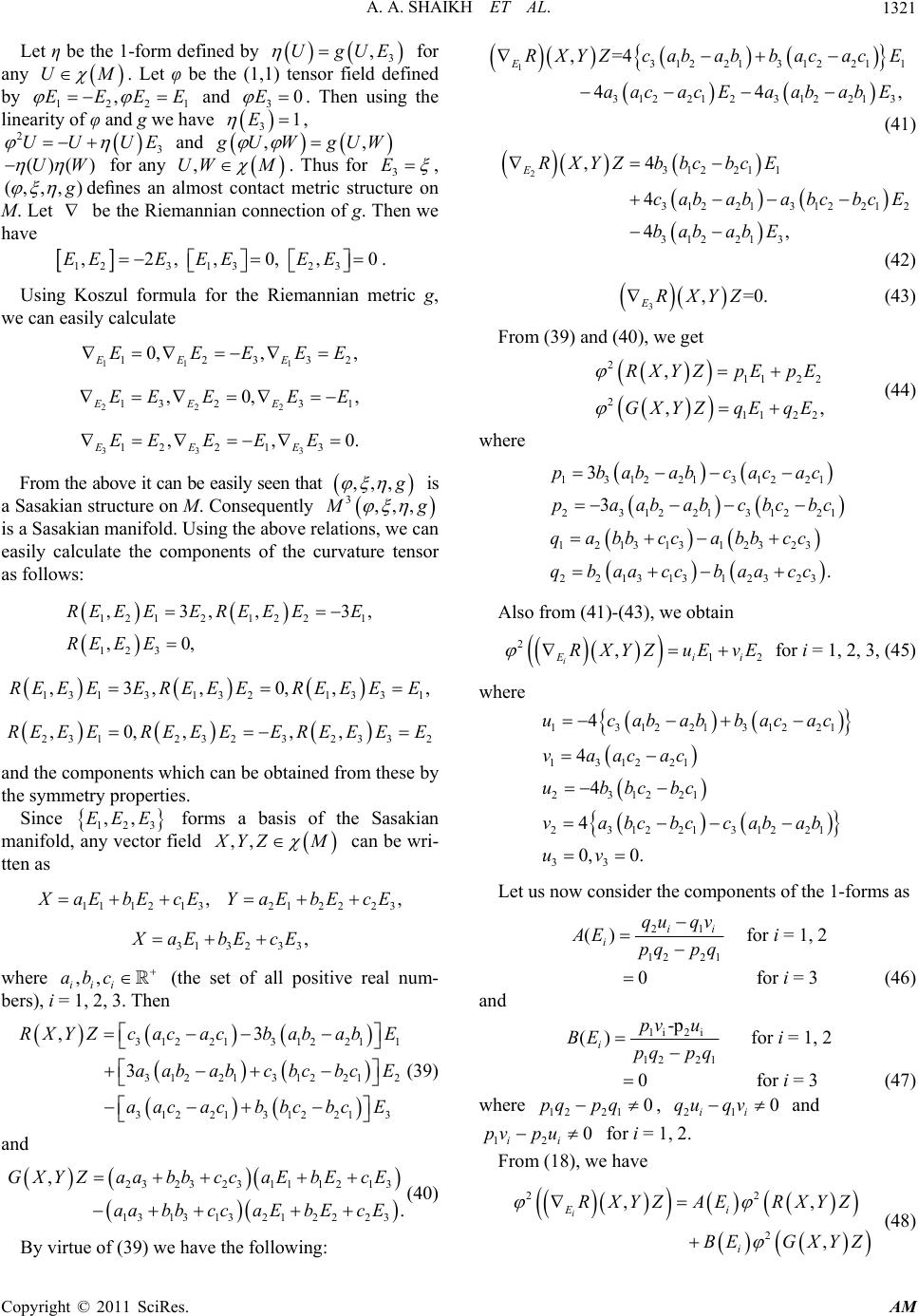 A. A. SHAIKH ET AL.1321 Let η be the 1-form defined by for any . Let φ be the (1,1) tensor field defined by 1221 3 ,UgUE UM ,EE EE and 30E . Then using the linearity of φ and g we have 1 3 E , and 3 UE 2UU ,, UW gUW ()( )UW for any . Thus for 3 ME,UW , (,,, ) defines an almost contact metric structure on M. Let be the Riemannian connection of g. Then we have 123 1323 ,2, ,0, ,0EEEEEEE . Using Koszul formula for the Riemannian metric g, we can easily calculate 11 1 1233 0,, , EE E EEEE 2 E , 0. 222 1323 1 ,0, EEE EEEE E 33 3 122 13 ,, EE E EEE EE From the above it can be easily seen that ,,, 3,,, is a Sasakian structure on M. Consequently g is a Sasakian manifold. Using the above relations, we can easily calculate the components of the curvature tensor as follows: 12 121221 12 3 ,3,, 3 ,0, RE EEERE EEE RE EE , , 13 1313213 31 ,3,, 0,,REE EEREE EREEEE 23 123232332 , 0,,,,RE EERE EEE RE EEE and the components which can be obtained from these by the symmetry properties. Since forms a basis of the Sasakian manifold, any vector field 123 ,,EE E ,, YZ M can be wri- tten as 11 1213 , aE bEcE 212 223 ,YaEbE cE 31 3233 , aE bEcE where (the set of all positive real num- bers), i = 1, 2, 3. Then ,, iii abc 312 21312211 31221312 212 31221312 213 ,3 3 RXYZc acacb ababE aab abcbc bc E aac acbbc bc E (39) and 232323 111213 1 31313212223 , . GX YZaabbccaEbEcE aabbcca EbEc E (40) By virtue of (39) we have the following: 1312 21312 211 312 212312 213 ,=4 44, ERXYZcab abbacacE aac acEaab abE (41) 231221 1 31221312212 31221 3 ,4 4 4, ERXYZbbc bcE cab ababcbcE bab abE (42) 3,= ERXYZ0. (43) From (39) and (40), we get 2 112 2 2 1122 , ,, RXYZpE pE GXYZqEqE (44) where 13122131221 2312213122 1213131 2323 221313 12323 3 3 . pbababcacac paababcbcbc qabbcc abbcc qbaacc baacc 1 Also from (41)-(43), we obtain 2 1 , i Ei RXYZuE vE 2i for i = 1, 2, 3, (45) where 1312213122 131221 231221 23122131221 33 4 4 4 4 0, 0. ucababbacac vaacac ubbcbc vabcbccabab uv 1 Let us now consider the components of the 1-forms as 21 12 21 () i i qu qv AE pq pq i for i = 1, 2 0 for i = 3 (46) and 1i2 i 12 21 -p () i pv u BE pq pq for i = 1, 2 0 for i = 3 (47) where 1221 0pqp q 12 0 ii pu , and 21 0 ii qu qv pv for i = 1, 2. From (18), we have 22 2 ,, , i Ei i R XYZAERXYZ BE GXYZ (48) Copyright © 2011 SciRes. AM 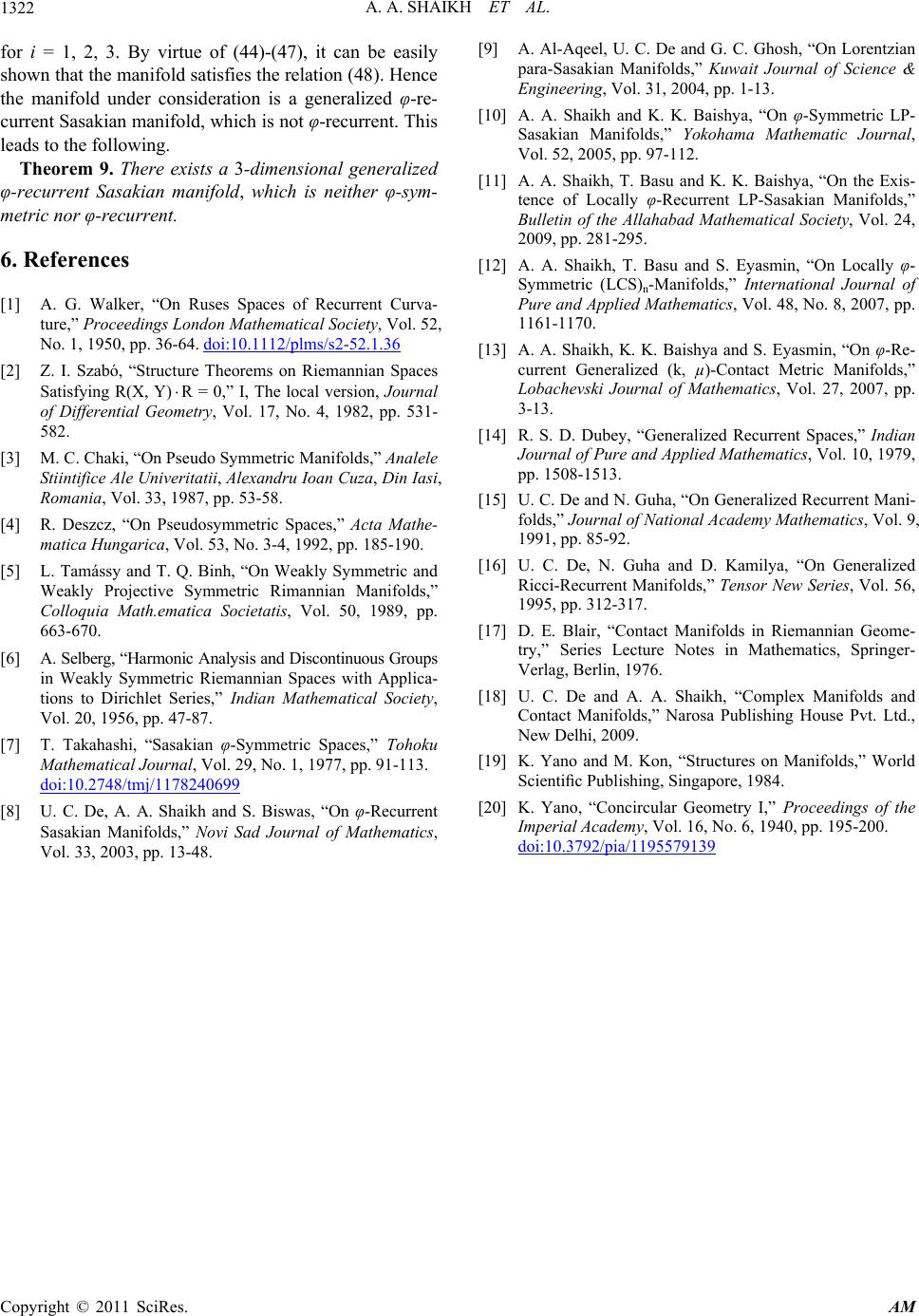 A. A. SHAIKH ET AL. Copyright © 2011 SciRes. AM 1322 [9] A. Al-Aqeel, U. C. De and G. C. Ghosh, “On Lorentzian para-Sasakian Manifolds,” Kuwait Journal of Science & Engineering, Vol. 31, 2004, pp. 1-13. for i = 1, 2, 3. By virtue of (44)-(47), it can be easily shown that the manifold satisfies the relation (48). Hence the manifold under consideration is a generalized φ-re- current Sasakian manifold, which is not φ-recurrent. This leads to the following. [10] A. A. Shaikh and K. K. Baishya, “On φ-Symmetric LP- Sasakian Manifolds,” Yokohama Mathematic Journal, Vol. 52, 2005, pp. 97-112. Theorem 9. There exists a 3-dimensional generalized φ-recurrent Sasakian manifold, which is neither φ-sym- metric nor φ-recurrent. [11] A. A. Shaikh, T. Basu and K. K. Baishya, “On the Exis- tence of Locally φ-Recurrent LP-Sasakian Manifolds,” Bulletin of the Allahabad Mathematical Society, Vol. 24, 2009, pp. 281-295. 6. References [12] A. A. Shaikh, T. Basu and S. Eyasmin, “On Locally φ- Symmetric (LCS)n-Manifolds,” International Journal of Pure and Applied Mathematics, Vol. 48, No. 8, 2007, pp. 1161-1170. [1] A. G. Walker, “On Ruses Spaces of Recurrent Curva- ture,” Proceedings London Mathematical Society, Vol. 52, No. 1, 1950, pp. 36-64. doi:10.1112/plms/s2-52.1.36 [13] A. A. Shaikh, K. K. Baishya and S. Eyasmin, “On φ-Re- current Generalized (k, µ)-Contact Metric Manifolds,” Lobachevski Journal of Mathematics, Vol. 27, 2007, pp. 3-13. [2] Z. I. Szabό, “Structure Theorems on Riemannian Spaces Satisfying R(X, Y)R = 0,” I, The local version, Journal of Differential Geometry, Vol. 17, No. 4, 1982, pp. 531- 582. [14] R. S. D. Dubey, “Generalized Recurrent Spaces,” Indian Journal of Pure and Applied Mathematics, Vol. 10, 1979, pp. 1508-1513. [3] M. C. Chaki, “On Pseudo Symmetric Manifolds,” Analele Stiintifice Ale Univeritatii, Alexandru Ioan Cuza, Din Iasi, Romania, Vol. 33, 1987, pp. 53-58. [15] U. C. De and N. Guha, “On Generalized Recurrent Mani- folds,” Journal of National Academy Mathematics, Vol. 9, 1991, pp. 85-92. [4] R. Deszcz, “On Pseudosymmetric Spaces,” Acta Mathe- matica Hungarica, Vol. 53, No. 3-4, 1992, pp. 185-190. [16] U. C. De, N. Guha and D. Kamilya, “On Generalized Ricci-Recurrent Manifolds,” Tensor New Series, Vol. 56, 1995, pp. 312-317. [5] L. Tamássy and T. Q. Binh, “On Weakly Symmetric and Weakly Projective Symmetric Rimannian Manifolds,” Colloquia Math.ematica Societatis, Vol. 50, 1989, pp. 663-670. [17] D. E. Blair, “Contact Manifolds in Riemannian Geome- try,” Series Lecture Notes in Mathematics, Springer- Verlag, Berlin, 1976. [6] A. Selberg, “Harmonic Analysis and Discontinuous Groups in Weakly Symmetric Riemannian Spaces with Applica- tions to Dirichlet Series,” Indian Mathematical Society, Vol. 20, 1956, pp. 47-87. [18] U. C. De and A. A. Shaikh, “Complex Manifolds and Contact Manifolds,” Narosa Publishing House Pvt. Ltd., New Delhi, 2009. [7] T. Takahashi, “Sasakian φ-Symmetric Spaces,” Tohoku Mathematical Journal, Vol. 29, No. 1, 1977, pp. 91-113. doi:10.2748/tmj/1178240699 [19] K. Yano and M. Kon, “Structures on Manifolds,” World Scientific Publishing, Singapore, 1984. [20] K. Yano, “Concircular Geometry I,” Proceedings of the Imperial Academy, Vol. 16, No. 6, 1940, pp. 195-200. doi:10.3792/pia/1195579139 [8] U. C. De, A. A. Shaikh and S. Biswas, “On φ-Recurrent Sasakian Manifolds,” Novi Sad Journal of Mathematics, Vol. 33, 2003, pp. 13-48.
|